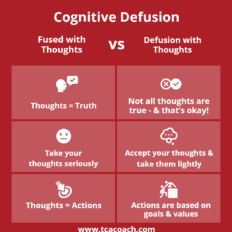For many people who experience challenges with anxiety and OCD, they have limited control over the content of the thoughts that run through their head. In fact, some of the newer neurobiology research suggest that persons with OCD may have a functional impairment in the structures of the brain responsible for “gate keeping” which thoughts reach their conscious awareness.
The problem is, we live in a society that reinforces this idea that “it’s the thought that counts.” We are made to believe that we are responsible for the thoughts in our head, and many people begin to identify themselves with their thoughts or may mistake their thoughts for “truth.”
For example, someone may have a “bad” thought about someone and began to label themselves as a “bad person.” Or someone may be worried about what other people think and truly believe that other people are thinking negative things about them.
In Acceptance and Commitment Therapy (ACT) this concept is called cognitive fusion and is described as the phenomenon of getting “attached” or “entangled” with the content of your mind. This is where typical CBT strategies, such as cognitive restructuring, can be counterproductive to address the anxious thoughts. In ACT, one is encouraged not to try to change, fight, or avoid the thought, but rather acknowledge and observe the thought is happening.
Rather than being the thinker of the thought, one should aim to be the observer who is watching thoughts come and go in their mind. After all, if you are aware that you are thinking something, are you the one thinking it or are you the awareness that’s watching yourself think?
 This concept of noticing the thoughts in your head and choosing to observe them rather than engage them, is called cognitive defusion. This ACT based skill is incredibly effective for helping people manage their anxious thoughts in a functional and effective way. With cognitive defusion, the purpose of the skill is to teach people how to live with their distressing thoughts, rather than try to make it go away.
This concept of noticing the thoughts in your head and choosing to observe them rather than engage them, is called cognitive defusion. This ACT based skill is incredibly effective for helping people manage their anxious thoughts in a functional and effective way. With cognitive defusion, the purpose of the skill is to teach people how to live with their distressing thoughts, rather than try to make it go away.
So next time you experience some anxiety, try to defuse yourself from the thoughts. You can do this by stating “I’m noticing that I am having the thought…” creating some space for the notice of the thought. You can also use imagery, such as imagining your thoughts like clouds in the sky passing by or hanging around for awhile. But most importantly, the goal is noticing your thoughts, stay present in the moment despite their presence, and engage in activities that align with your values.
After all, “it’s not the thought” that counts… it’s the way we respond to them.


